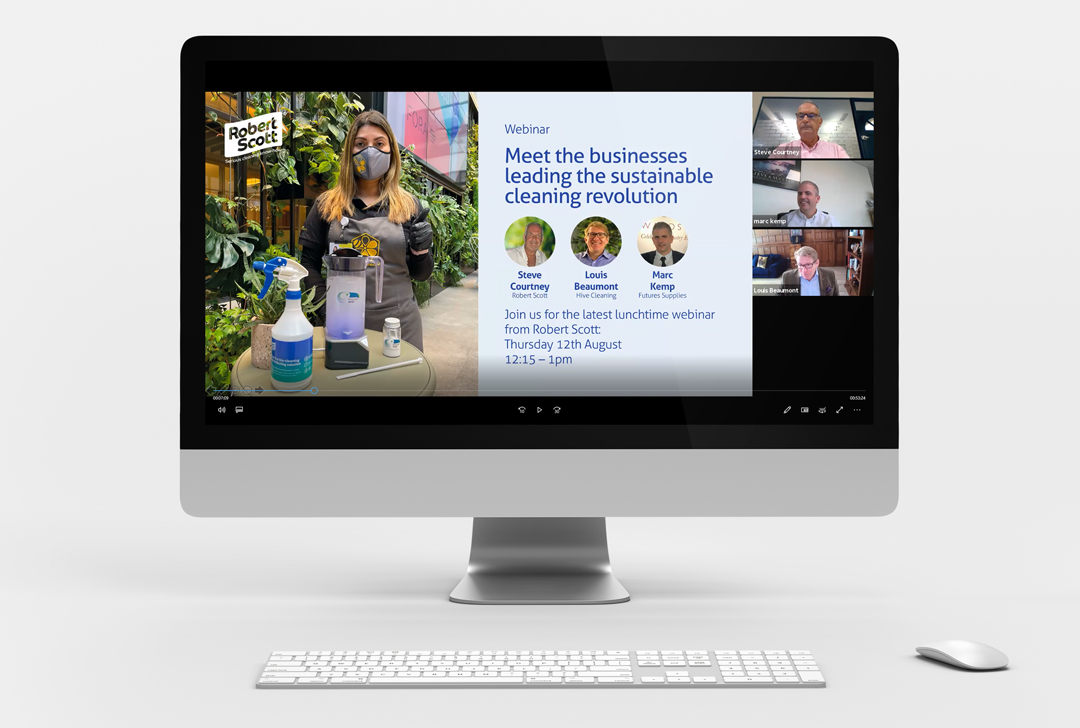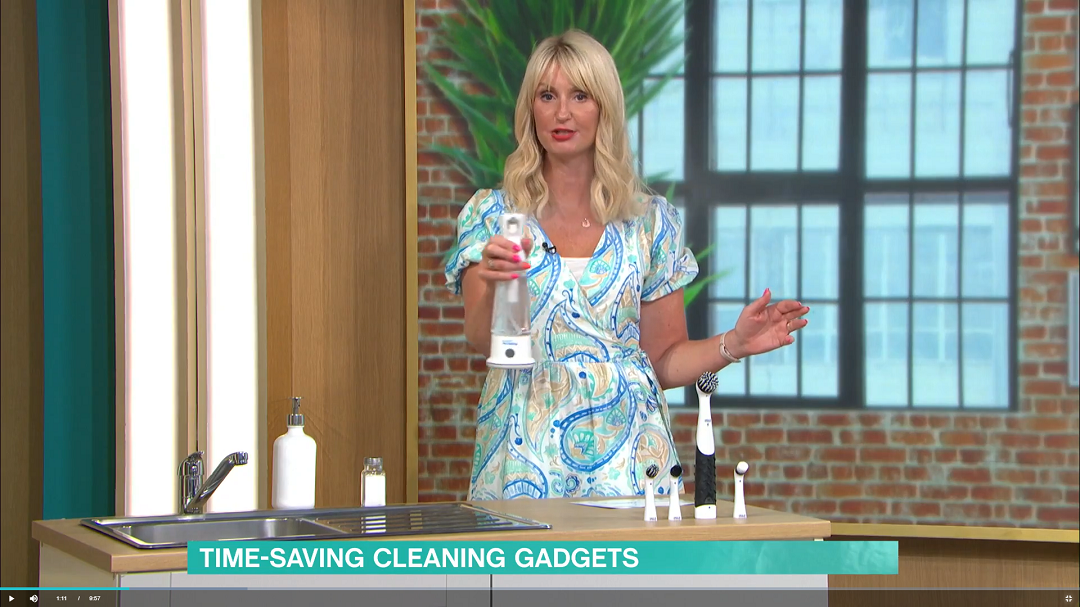What’s the hype about hypochlorous acid?
Jump to section
Subscribe to news
Here we take a look at hypochlorous acid (or HOCl), which is a weak acid that’s produced by the human body as part of our immune system’s defence against infection.
We discuss why more and more cleaners are using hypochlorous as an effective, eco-friendly and safe disinfectant in the fight against germs. And how it’s made just from water, salt and electricity. That’s it.
Let’s design a new way to disinfect
Before we start, if we designed a new multi-purpose antibacterial cleaner from scratch, what would we want it to do?
- Top of the list is efficacy – how well it kills microorganisms, and especially highly-resistant spores and viruses, which are used as the gold standard for microbial effectiveness.
- And then there’s the speed of kill and regrowth rate. It must kill germs quickly without having to leave the solution for minutes or longer to be effective – this is known as ‘contact time’. And once it kills, the germs remain dead. These requirements of the speed of kill, efficacy and regrowth allow us to assess the kill kinetics of a disinfectant.
- It should be easy and quick to use, ideally without any remaining sticky chemical residue or smear, without the need to rinse off harmful chemicals, and replacing lots of different chemical bottles.
- Safety must be high up there too so there’s no harm to the cleaner or the public, either from skin contact, accidental ingestion or inhalation, and without the need for PPE equipment such as gloves.
- It should be good for the planet – by being chemical-free and reducing the huge amount of single use plastic bottles synthetic chemicals come in which most often ends up in landfill.
- The solution would have to pass the relevant disinfecting certifications of course.
- And it should cost the same or, even better, save you money.
We now know what this solution should do, but is there one that ticks all of the above boxes? There is now, and that’s why at Toucan Eco we believe hypochlorous acid is a real game changer for the cleaning industry.
Now onto chlorine and disinfectants.
Hypochlorous acid as a disinfectant
Not all chlorine species are the same – or as effective. Studies exploring the mechanism of chlorine disinfection can’t precisely identify how each particular chlorine species works, but it’s a mix of:
- Rapid oxidation reactions with cell walls or other vital cell components including proteins, nucleic acids and key enzymes rendering them non-functional. This is measured by Reactive Oxygen Species (or ROS).
- And the rate of diffusion through the cell wall – so how quickly it penetrates into pathogen cells.
Hypochlorous works on both levels and that’s why it’s widely regarded as being 100 times more effective than more commonly used disinfectants in the chlorine family, such as bleach.
Most disinfectants kill by penetrating the cell wall and killing the RNA or DNA, but this can take 1, 5 or 10 minutes or longer. As hypochlorous acid has high oxidation values it oxidises cell walls very quickly, penetrating the cell and killing them within seconds.
This results in an osmotic overload (put simply, a chemical imbalance of a cell) which means the cell cannot keep its structure, becomes vulnerable to attack, and reacts with proteins and nucleic acid.
Hypochlorous is neutrally charged while bacteria is generally negatively charged. And, just like magnets, molecules with the same charge will repel each other.
That’s why hypochlorous easily penetrates bacterial cell walls, and either oxidizes the cell walls killing the bacteria or enters through the cell walls and destroys the vital components inside the cells.
This high reactivity explains why it turns back into salt water, and hence its relatively short lifespan. And why, you simply make more when you need it.
As the process works on a molecular level this means that microorganisms are unable to build up resistance, something which can occur with chemical disinfectants. Although the speed of kill is proven to take seconds, it also has a residual effect and keeps on working if left on surfaces.
It’s tested to kill the norovirus (log-5) and poliovirus (log-6), both harder-to-kill viruses than the coronavirus, as well as against the likes of E. coli, MRSA and Listeria.
And it’s also unique in that it’s non-toxic to humans and animals – in fact our bodies make it and more about this below – while it’s lethal to almost all known dangerous bacteria and viruses that threaten our health.
Just bear in mind that the ‘acid’ of hypochlorous acid is a slightly confusing term as the solution made by Toucan Eco is at a gentle pH, especially when compared with harsh acidic or alkaline chemicals.
What’s changed now?
Until recently, it hasn’t been possible to create hypochlorous acid as a stable solution.
The challenge has been to create hypochlorous acid at a near neutral pH and in a stable form as it wants to as it reacts with organic matter and revert back to salt water.
With developments in technology, smaller devices now make the solution on demand and to last longer.
What is hypochlorous acid used for?
Today, this technology is trusted by a huge range of industries. It protects the marine environment, disinfects drinking water, combats Legionella, and is used to safely disinfect and clean in everything from fish processing to carpet cleaning, salad packing to flower cultivation and dairy farming.
It’s already widely used to disinfect in America, Japan and South Korea, and also for medical use, again in the US, where hypochlorous acid is registered with the Food & Drug Association (or FDA) to treat wounds, burns and infections. In fact, it’s been used in this way, and before antibiotics were available, to clean wounds during World War I.
Hypochlorous acid uses
Hypochlorous is being used in portable shower booths by coronavirus swab test health workers to disinfect their clothing after finishing a gruelling 5-hour shift. It’s being used to disinfect ambulance cabins by installing a misting system to spray cabins.
And it’s also being used as part of a scheme called Project India along the river Ganges to help make the world’s polluted water safe to drink in third world countries and areas of humanitarian disaster.
Back in the UK, more and more companies are now proving you don’t have to use toxic, environmentally-damaging and expensive synthetic chemicals to disinfect and clean workplaces, while removing the single-use plastic bottles they’re supplied in at the same time.
Science based on the immune system
Hypochlorous is a weak acid that also naturally occurs in our body to fight infection. When we come under attack from invading bacteria and viruses, the immune system responds by sending white blood cells called neutrophils straight to the infection.
These neutrophils chase down and engulf pathogens, shown here, releasing a burst of antibacterial chemicals, including hypochlorous, which tears down the cell membranes and proteins. Toucan Eco technology creates the same hypochlorous solution as the human body, but in a more concentrated form.
How does Toucan Eco make hypochlorous acid?
It’s called electrochemical activation (or ECA for short) and it’s a form of electrolysis where an electrical current is passed using a specialised cell through a solution of water (H20) mixed with a small amount of salt (NaCL). The electrolysis breaks the compounds apart into their basic elements.
Then, the reaction oxidises at the positively charged electrode (the anode) and reduces at the negatively charged electrode (the cathode).
At the positive anode, the hydrogen and oxygen in the water reacts with the chlorine in the salt to produce the main, active disinfectant of hypochlorous acid (HOCl).
At the negatively charged cathode, the sodium and chlorine in the salt combines with the oxygen in the water to produce a low concentration of sodium hypochlorite (NaOCL). With a slightly raised pH level, this acts as a gentle cleaning agent.
What is its shelf life?
The solution is designed to remain effective for between five to seven days, after which point it reverts back to slightly salty water that can either be poured away or reactivated. Our advice is to make as much as you need for the cleaning job at hand and, as it’s virtually free to make, there’s no point in storing it for days. You simply make it on demand.
What is the contact time and rate of regrowth?
Independent tests prove that the solution kills virtually on contact. That’s not the case with synthetic chemicals which can take 1, 5, 10, 15 minutes or longer to be effective before wiping off.
And how quickly do any surviving microorganisms recover and start to multiply after the solution has been applied? In trials, after 24 hours there wasn’t any evidence of regrowth. More information on this here.
And is Toucan Eco, well, eco-friendly?
Most definitely! The solution has minimal environmental impact and reduces the use of harmful chemicals and the single use plastic bottles they are supplied in. So, no phthalates, ammonia, additives, even fragrances.
There’s no need for COSHH training or protective equipment, and it doesn’t harm the environment or air quality.
The solution is generated from natural and sustainable compounds of water and salt, and minimal amounts of electricity is required. Due to its gentle pH, concentration level, and the fact that the solution is made of 99.9% water, it’s very safe, non-toxic and hypoallergenic, and so doesn’t require PPE when using it.
And, as the solution is made on-site, there’s also less transport impact, packaging or waste product disposal.
A note about bleach
As we all know, bleach is widely used to disinfect and the most common form of this is sodium hypochlorite, which shares the same chlorine family as hypochlorous. This is usually found at a concentration of around 5% in household bleach.
But it does come with negatives. Bleach is highly irritating to the eyes, skin and lungs, and inhalation over long periods could be carcinogenic. It can also leave a residue, is corrosive to some metals and, most importantly, isn’t as reactive with organic matter.
In contrast, hypochlorous has a temporary, mild chlorine smell that dissipates quickly; it is hypoallergenic and completely safe. And, while the solution does include sodium hypochlorite – providing its cleaning properties – it’s 500 times less concentrated than household bleach.
Hypochlorous as a hand sanitiser
While alcohol is a popular disinfectant in hand sanitisers, if used on a daily basis it often leads to hand dermatitis – this has been mentioned many times during the coronavirus outbreak with people complaining of dry, cracked hands, including amongst children with more sensitive skin.
Hypochlorous can also be used in place of hand sanitiser with no irritating side effects, and is an effective way of killing pathogens without these side effects. In this way it acts as an antiseptic and can be safely used on the skin.
And why is it a game changer for the cleaning industry?
If we go back to our wish list of what we’d want a disinfectant to be, hypochlorous acid really does tick all of the boxes.
| Efficacy | Speed of kill | Regrowth rate | Safety | Environmental | Certifications | Cost |
 99.999% 99.999% |
 In seconds In seconds |
 Very slow Very slow |
 Non-toxic & hypoallergenic Non-toxic & hypoallergenic |
 No plastic waste or chemical use No plastic waste or chemical use |
 EN1276 & EN13697 EN1276 & EN13697 |
 Saves money Saves money |
That’s why businesses and households would benefit from using hypochlorous acid as the greener way to disinfect, and in a way that’s chemical and plastic free.
It’s also why more and more businesses are adopting this technology to support their carbon reduction schemes. And this now includes the likes of Somerset House of London, HOME Manchester, UWC Atlantic College in Wales and Michelin-starred restaurant Alchemilla of Nottingham.
SHARE THIS:
Tags: Chlorine, Disinfectant, Hypochlorous acid, Toucan Eco




